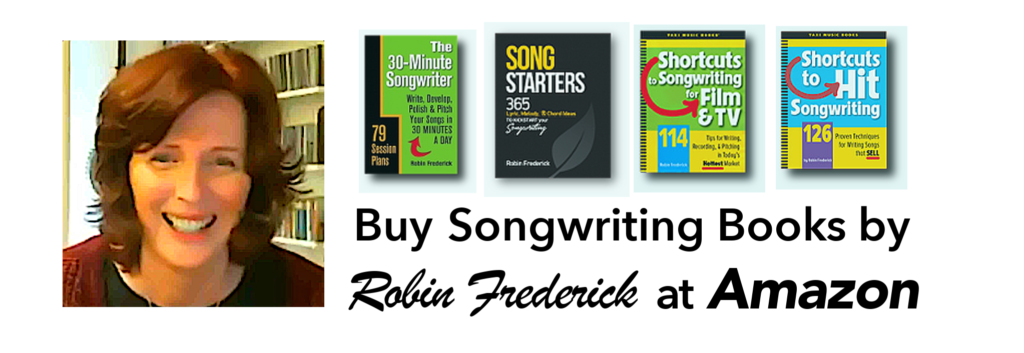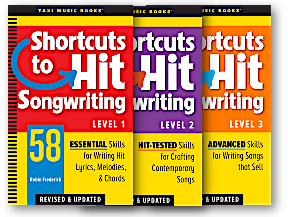You’re Inspired! You woke up in the middle of the night with a killer first verse running through your head. You actually sat up in bed and said: “Man, that’s killer!”
You managed to write it down before you forgot it. Maybe you even got up and plunked a few chords on the piano. Suddenly you felt like Sting writing “Every Breath You Take.” You even recorded your inspiration onto the Voice Memo on your Smartphone before going back to sleep.
Now, in the cold light of morning, you listen back to it. Amazingly, it still sounds good!
So now, you need a chorus. Nothing pops into your head right away, so you go to the notebook where you keep lyric ideas. (Good for you for keeping a notebook!) There’s a line you’ve wanted to use for months and this looks like a good opportunity. Bingo! You’ve got the first line of your chorus. You can’t really think of a second line, so you just repeat the first one a few times.
But wait a minute. Repeating a lyric phrase, even if you change the chords and melody underneath, can feel static. There’s not enough development to keep the song moving forward and listeners involved. And you can’t think of anything at all to say in your second verse. These are signs that there’s trouble up ahead.
As you continue to work on your song…
- Nothing seems to fit with your first verse.
- Everything you write sounds forced and unnatural.
- You can’t get back to the inspired feeling you had.
- Your lyric “voice” has changed. It sounds like someone else is writing the song.
After struggling with a chorus and second verse, writing and rewriting hour after hour, you begin to get tired of this song. You don’t like it anymore. You put it away and it becomes one of the Unfinished Ones. But it was off to such a great start. What happened?
Writing from inspiration
Inspiration is a wonderful thing and it always has a big role to play in the writing process. It gives us those gems that add color and life to a lyric, special insights that create depth, unique melody twists that surprise us at just the right time. Inspiration is playful, exciting, and refreshing.
The problem with inspiration is that it is neither linear nor selective. It gives you everything all at once! It might even be giving you ideas for a different song. Inspiration is either ON or OFF. And once it’s ON, like dreams, it will work on anything that’s happening in your subconscious.
Often we hope a song will reveal itself as we write. And sometimes it does. When that happens, say “thank you” to your inspiration and go record it. But far more often, there are lyric or melody lines that are confusing, blur the focus, or create a sense of aimless wandering. Listeners don’t like ANY of those things.

It’s up to your conscious mind to select and put in order the things your inspiration gives you. The trick is to enhance your inspired ideas, not destroy them. Keep the leash loose enough to allow your inspiration to explore while you take the goodies and turn them into something you can build on and listeners can relate to.
Here are some tips on how to do that. Use these techniques to find out what your inspired verse or line is about so you can build the other sections of your song on it. And, when inspiration drops something new into your lap, you can decide if it belongs in this song or somewhere else.
Find out what you’re really writing about
INTERVIEW YOURSELF – Write down the answers to these questions in short phrases (five to ten words). Include any images, words, or ideas that come to mind.
- What is it you want to say?
- How do you feel about it?
- When you strip away specific events or details, what is left?
- What is the most important thing you want listeners to understand?
Now, in as few words as possible, express the essential truth or emotion at the heart of your song. You may want to take a break, then come back and read over your answers to the questions above before you do this.
WRITE FROM A TITLE OR FIRST LINE – Choose the line you used for your chorus OR the first line of your verse (not both). Write the line at the top of a page. Make a list of questions that you and your listeners might have about that line and write out the answers in short phrases. Answer questions like:
- What does that mean?
- Why are you saying that?
- What happened that made you feel that way?
- What does that feel like?
Now, look at the verse and chorus you wrote. Are they both answering the same or similar questions? Are the answers similar or different? If the answers are different, you may be writing two songs. Decide which song you want to write first. Put the other song section aside and use it to start another song.
USE IMAGES AND ACTION WORDS – Using the title or first line of your song, make a list of images, phrases, ideas, and action words that come to mind. Don’t be too critical; just write down anything you think might be related. Then make another list and write down any images, phrases, ideas, or action words related to the list you just wrote.
For instance, if you have the word “love” in your title, what color, what physical feeling, what season, what action does it make you think of. Then use those words to suggest others. You should end up with lots of words, phrases, images, and actions, some of which you’ll use and some you won’t. But ALL these words are related somehow to your initial title or line. They should be able to help you write new lines that will keep your lyric on track.
USE LEADING PHRASES – At the end of your inspired verse or chorus, write the phrase “This is what I really need to say to you…” then finish the sentence. If you can think of several ways to finish the sentence, see if they’re all saying the same (or similar) things. If so, then you can use them all in your lyric. If they’re saying different things, start other songs with some of them. By the way, you don’t need to use the leading phrase in your lyric, just use it to get into the idea you want to express. More leading phrases:
- What I mean is…
- How I really feel is…
- If I could say one thing it would be…
- I want…
- I don’t want…
USE MELODY PATTERNS – Got a great idea for a melody? Usually these ideas are one or two lines long, maybe a little more. But what happens after that? Think in terms of patterns of repetition and variation. For example, repeat a single melody line, then go away for the next line. Then repeat all three lines but change the last one to add a little surprise. Like this:
- Melody line 1
- Melody line 1
- Melody line 2
- Repeat all three lines with a twist at the end.
Keep your melody organized into different patterns in each song section. Use phrases of different lengths in each section or change the rhythm of the melody to create contrast between sections. Use your inspiration to come up with the first line, then build on it.
Writing your chorus
Your chorus needs to sum up the emotional heart of your song so, by the time you start writing it, you should know what your song is about. Whether you choose to start with a title or the first line of an inspired verse, using some of the techniques I listed above should get you pretty close.
Lyrically, the chorus often starts with the title and ends with a final insight, wrap up, or “payoff line.” Both first and last lines need to express the song’s central idea or tell us something about the emotional heart of the song.
The chorus melody range is frequently higher than the verse because a higher note range is usually more emotionally expressive. The melody then resolves back to the verse range for the payoff line. Within those general guidelines there’s a whole world of choruses. Listen to a few recent hit songs that you like to hear how a chorus lyric and melody is structured.
Second Verse Syndrome
Sometimes you can get through both a first verse and chorus without having a clear idea what your song is about. But you’re not out of the woods yet! There’s still the second verse and bridge to deal with.
Often, in weak songs, the second verse and bridge seem unrelated to the first verse and chorus. Be aware that listeners won’t make the leap from one emotion or situation to a different one. They’ll just stop listening. So you need to develop your second verse and bridge in the same way you developed your chorus.
INTERVIEW YOURSELF – But ask different questions this time. Now you want to know…
- What do you think, hope, or fear might happen next? Or…
- What caused this to happen? Or…
- What else does this make you feel?
RELAX THE RHYME SCHEME – For some reason, it seems like inspiration loves to rhyme. I don’t know why but those big inspired sections tend to have tight rhyme schemes, ones that are very hard to replicate in other sections without sounding forced and unnatural. But you know what? No listener ever said “I’ve just gotta hear that song again… I LOVED that rhyme scheme!”
If your first verse has an insanely tight rhyme scheme, you can let it slide a little in your second verse. Use “near rhymes” instead of perfect rhymes. Here’s my favorite web site for near rhymes: RhymeDesk.com. Near rhymes offer a far greater range of rhyming words than perfect rhymes. Give yourself a break.

As a last resort, if you need to, you can relax the first verse rhyme scheme a little. You don’t have to rhyme absolutely every line. If it won’t hurt the lyric, change a word or phrase so it doesn‘t rhyme. With rhymes, more is not always better.
Here are a few more ideas on rhyming… or not.
LOOK FOR CREATIVE SOLUTIONS – If you’re really stuck, take a break from your song. Read other song lyrics that you admire and notice how those writers solved the problem. What did they write about in the second verse or bridge? What questions did they answer? How did these sections relate to the first verse and chorus? You don’t want to steal. Just look for techniques and solutions and apply them to your own style and song.
Inspiration can also be generic and familiar
Sometimes “inspiration” is really just the first thing that popped into your head. It could be the result of habit and familiarity. These melodies and lyrics tend to be derivative of others you’ve heard. If you think you’ve heard something similar in another song, try making a few changes just to be safe. Raise or lower the pitches in a melody line or change the rhythm of the notes. Replace a tired lyric cliché with a fresh image or idea.
Here are some tips for rewriting clichés.
Do It Now
Look through your back catalog and lyric notebooks for unfinished songs or ones that could use a rewrite to add focus. Use some of the suggestions in this Songwriting Tip to develop a second verse and bridge, add focus to a chorus, or clarify your theme so that listeners can understand your song and feel what you felt when you wrote it.
Enjoy, explore, and make friends with your inspiration!


